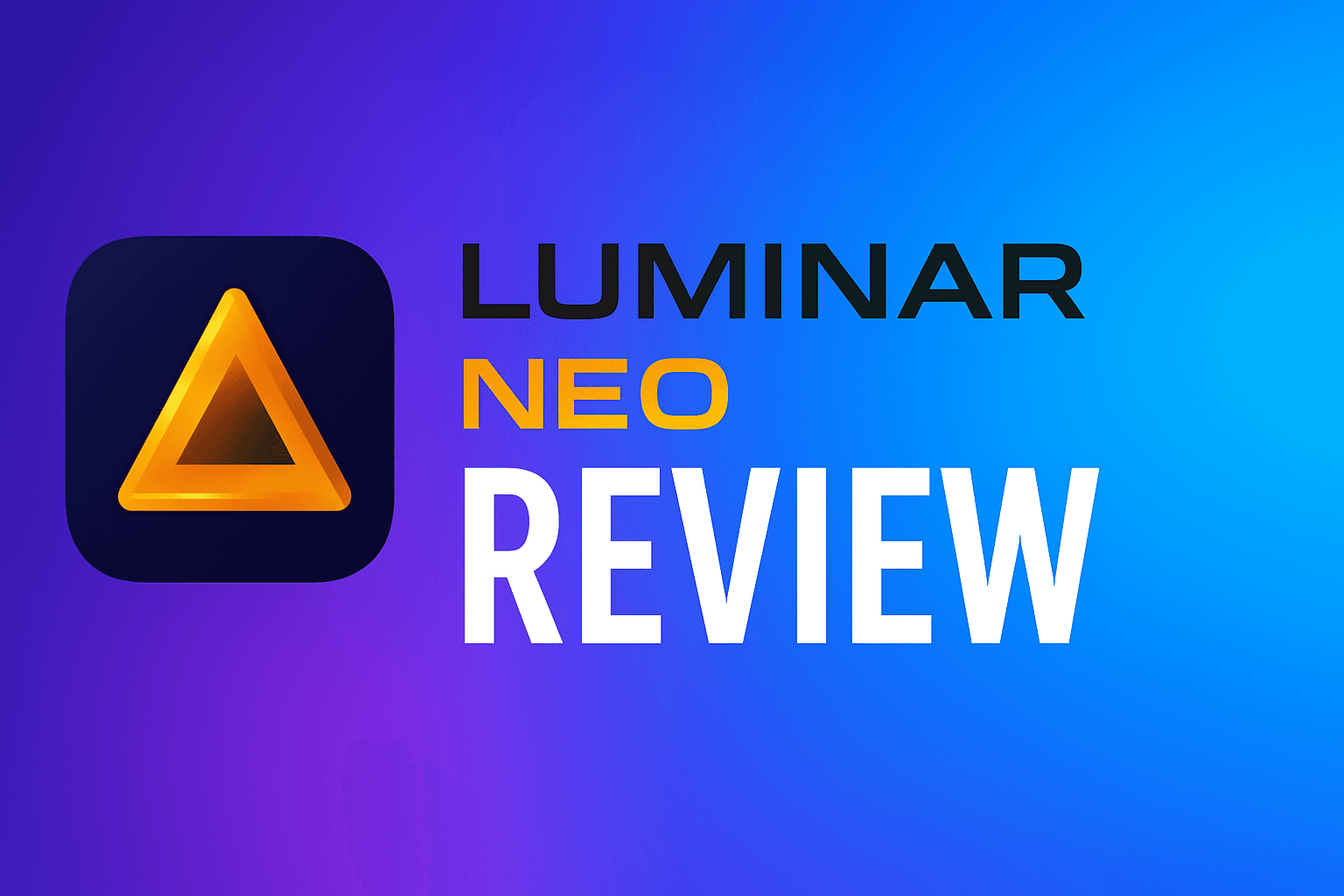If you’re looking for an honest Luminar Neo review, you’re in the right place. Luminar Neo is Skylum’s flagship AI-powered photo editing software, designed to make complex edits simple while still offering professional-level tools. In this review, we’ll explore its features, performance, pricing, pros and cons, and see whether it’s truly worth adding to your editing toolkit.
Luminar Neo at a Glance (Quick Summary)
Before diving deeper into this Luminar Neo review, it’s worth taking a quick look at what makes the software stand out. Luminar Neo, developed by Skylum, is an AI-powered photo editing software built to make complex editing fast, intuitive, and professional. In my experience, it strikes an impressive balance between automation and creative control, which makes it a great fit for both beginners and advanced photographers.
Key Highlights of Luminar Neo
- AI-Driven Editing:
You’ll notice that tools like Sky AI, Relight AI, Skin AI, and Background Removal AI automate time-consuming edits without compromising quality. These smart tools speed up your workflow while maintaining a natural, polished look. - Creative Extensions:
Luminar Neo offers optional extensions such as Supersharp AI, Noiseless AI, HDR Merge, and Upscale AI, giving you advanced creative flexibility when you need it most. - Cross-Platform Functionality:
Whether you prefer working in Lightroom, Photoshop, or on Luminar Neo as a standalone editor, it integrates seamlessly across platforms. - Non-Destructive Workflow:
Every adjustment in Luminar Neo is fully reversible. You can tweak, undo, or fine-tune edits at any point without losing image quality. - Wide Compatibility:
Luminar Neo supports RAW file formats and runs smoothly on both Windows and macOS, making it accessible to a broad range of photographers.
Pros and Cons at a Glance: Luminar Neo review
After testing the software for this Luminar Neo review, I found several standout advantages — along with a few areas that could be improved. Here’s a quick summary to help you decide whether it’s the right photo editing tool for your needs.
✅ Pros
- Beginner-Friendly with AI Tools:
Luminar Neo’s intuitive interface and AI-powered features make it easy for anyone — even first-time users — to create professional-looking edits. - Flexible Pricing Options:
You can choose between a subscription plan or a lifetime license, depending on your budget and workflow preferences. - Fast Results, Minimal Learning Curve:
In my experience, Luminar Neo delivers quick, high-quality edits without requiring deep technical knowledge. - Creative Presets for One-Click Enhancements:
The built-in presets and looks allow you to instantly elevate your images with just a single click.
❌ Cons
- Performance on Older Systems:
Some users may experience slower performance when running Luminar Neo on outdated hardware or low-spec machines. - AI Results May Require Manual Tweaks:
While the AI tools are powerful, certain edits still benefit from a bit of fine-tuning for best results. - Advanced Features Locked Behind Extensions:
Some of Luminar Neo’s most advanced capabilities, such as Upscale AI or Noiseless AI, are only available through paid extensions.
Key Features of Luminar Neo
When going through any Luminar Neo review, it quickly becomes clear that what truly sets this photo editor apart is its advanced use of AI technology. In my experience testing Luminar Neo, I found that it combines intuitive controls with professional-grade power — making it a standout choice for photographers of all levels. Below, I’ve broken down the main features by category to help you understand what makes this software so effective.
Core Editing & AI-Powered Tools
These are the tools that many users will interact with most, and which often get highlighted in a Luminar Neo review:
- Enhance AI — Adjusts multiple image properties like color, tone, contrast, exposure with a single slider for quick improvements.
- Sky AI — Automatically detects sky in images and replaces or enhances the sky; works with relighting so the rest of the photo matches the new sky.
- GenErase, GenSwap, GenExpand (Generative AI tools) — Remove unwanted objects (GenErase), replace elements (GenSwap), expand image boundaries or content (GenExpand) to create more dynamic compositions.
- Atmosphere AI — Add realistic atmospheric effects like fog, haze, mist, etc.
- Relight AI — Adjust lighting in the image by separating foreground / background lighting, to improve depth and mood.
Image Quality & Extensions: Luminar Neo review
Luminar Neo comes with “extensions” (optional extra tools) plus high-quality enhancers for fine detail work. These are often highlighted in reviews as value-adding features.
- Supersharp AI — Sharpens details, recovers blur from motion or focus errors.
- Noiseless AI — Removes noise from low-light photos while preserving detail.
- Upscale AI — Allows upscaling images to much larger resolutions without major quality loss.
- Background Removal AI — Quickly isolates subject(s) and removes or changes background.
- HDR Merge, Panorama Stitching, Focus Stacking — For more advanced photography: combining multiple photos for better dynamic range, wider field of view, or fully sharp macro shots.
Ready to experience Luminar Neo’s AI speed for yourself? 👉 Try Luminar Neo Today
Essentials & Creative Controls
Beyond the AI tools and extensions, Luminar Neo gives standard controls and creative adjustment tools. These let users fine-tune their image and apply styles or mood.
- Develop module: exposure, contrast, color, tone adjustments etc.
- Structure AI: adding texture and clarity while preserving people/subject integrity.
- Color controls, mood effects, LUTs / filters / presets: quick transformations or consistent style across photo sets.
- Tools like Dodge & Burn, Clone, Crop, Composition AI: enable fine corrections and framing.
Platform Support & Workflow Tools
What good features are worth if the workflow is limited? Luminar Neo scores well on compatibility and workflow enhancements, which are often praised in a Luminar Neo review.
- Works as a standalone app (Windows & macOS), plugin for Lightroom, Photoshop, and others.
- Non-destructive editing: all changes can be undone or adjusted; layering and masking support (mask AI, manual masks).
- Raw format support & support for many image types (JPEG, TIFF, PNG, and many camera RAWs).
- Frequent updates: the developer (Skylum) regularly adds new features and improves performance.

User Experience & Interface: Luminar Neo review
In any Luminar Neo review, the user experience plays a major role — and for good reason. In my experience testing Luminar Neo, it’s clear that Skylum has done a great job of balancing simplicity for beginners with the advanced control professional photographers expect. The software feels clean, modern, and designed to keep you focused on creativity instead of technical hurdles.
Layout & Navigation
One of the first things you’ll notice about Luminar Neo is its intuitive layout. Everything feels well-organized, which makes editing sessions smooth and enjoyable.
- Clean, Modern Interface – The dashboard is straightforward, with editing tools organized clearly in the sidebar.
- Minimal Learning Curve – Beginners can quickly start editing thanks to intuitive sliders and one-click AI tools.
- Workspace Customization – Users can switch between essential tools for quick edits or dive deeper into advanced adjustments.
Workflow Efficiency
Efficiency is a big selling point in many Luminar Neo reviews, and from what I’ve seen, the software handles this very well.
- Non-Destructive Editing – Every change can be undone or adjusted later without harming the original photo.
- Catalog & Library – Luminar Neo allows you to organize, browse, and search your images easily, though it’s simpler than Lightroom’s catalog system.
- Fast AI Presets – Templates and presets help speed up editing for bulk workflows or photographers who need consistent results.
Ease of Use for Different Skill Levels
One of Luminar Neo’s biggest strengths is how it adapts to users of all experience levels.
- Beginners – Can rely on presets, AI-based corrections, and simple sliders for quick results.
- Enthusiasts & Professionals – Have access to manual controls, masking, layers, and RAW editing for precise fine-tuning.
- Plugin Integration – Seamless integration with Lightroom and Photoshop ensures pros can add Luminar Neo to existing workflows.
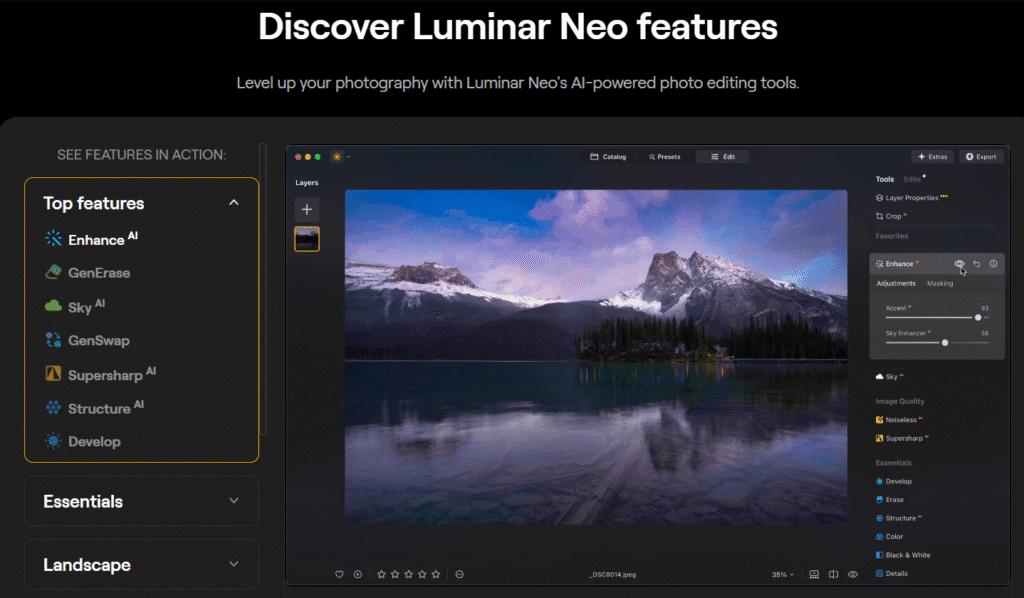
Performance & Speed: Luminar Neo review
A key part of any Luminar Neo review is how the software performs once you start editing. In my experience testing Luminar Neo across different systems, the performance largely depends on your computer’s hardware — but overall, it delivers a smooth and reliable experience for most users.
Even with its advanced AI-powered tools, Luminar Neo manages to stay responsive, especially when working with high-resolution images or complex adjustments. However, if you’re running it on older hardware, you might notice slight delays during tasks like AI sky replacement or batch editing.
System Requirements
Luminar Neo works on both Windows and macOS. The minimum and recommended specs help determine how smoothly the software will run:
- Windows: Windows 10 or later, Intel Core i5 processor or better, 8GB RAM (16GB recommended), DirectX 11 compatible graphics, 10GB free disk space.
- macOS: macOS 11.0 Big Sur or later, Intel Core i5 or Apple M1/M2 chip, 8GB RAM (16GB recommended), 10GB free disk space.
👉 Tip: The better your processor and graphics card, the faster Luminar Neo’s AI features will perform.
Speed of Its AI Tools
Luminar Neo uses advanced AI to automate tasks like sky replacement, noise reduction, and background removal. These can be demanding on system resources:
- Fast on Modern Systems – On newer machines, AI tools like Sky AI and GenErase deliver results in seconds.
- Slower on Older Hardware – Some users report noticeable lag with large RAW files or when applying multiple AI adjustments.
- Batch Processing – Templates and presets help speed up workflows when editing multiple images at once.
Stability & Updates
- Luminar Neo receives regular updates from Skylum that improve performance and fix bugs.
- Stability is generally good, though some early versions had reports of crashes when handling very large files.
- Performance is optimized better with each update, making newer versions smoother than initial releases.
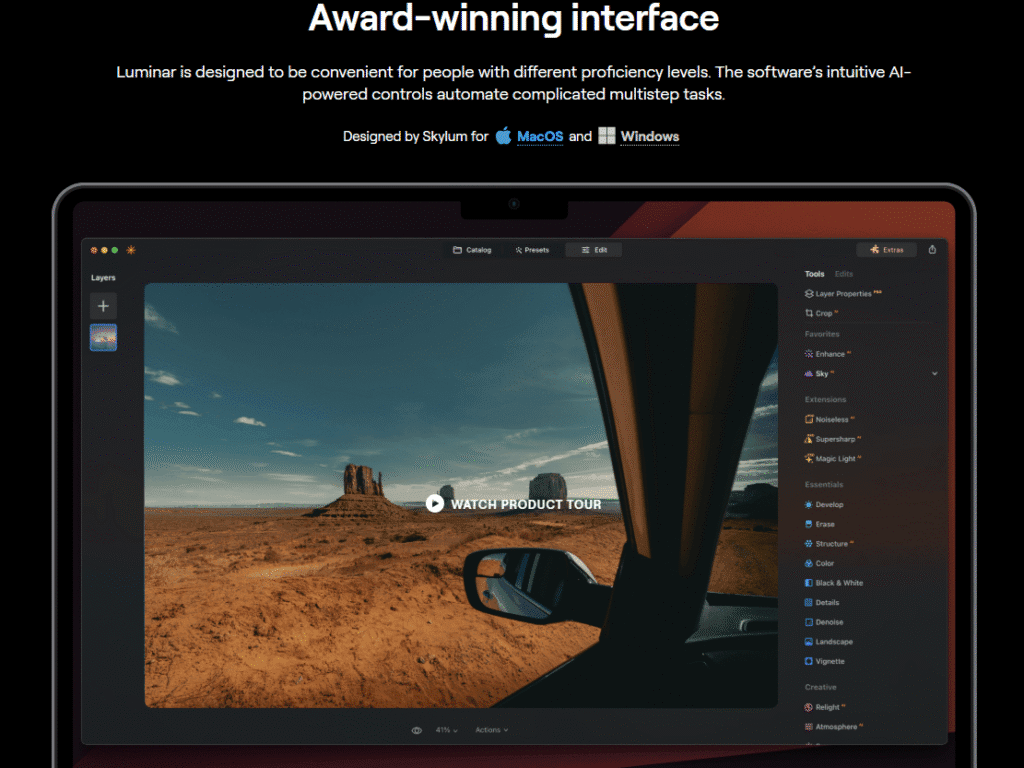
Pricing & Plans: Is It Worth the Cost?
In this part of the Luminar Neo review, we look at what you’ll pay, what you get, and whether the features justify the cost.
What Plans Does Skylum Offer?
Luminar Neo comes in several perpetual (one-time payment) licenses as well as options that bundle desktop + mobile access and creative assets. Skylum
Here are the main pricing tiers:
| Plan | What’s Included | Price* |
|---|---|---|
| Perpetual Desktop License | Luminar Neo for Windows/macOS; includes one year of unlimited upgrades | US$79 One-time payment |
| Cross-device Perpetual License | Desktop + Mobile (iOS/Android/ChromeOS); include one year of unlimited upgrades. | US$109 One-time payment |
| Perpetual Max License | All above + Creative Library access (assets, awards, add-ons, presets). This is Skylum’s most comprehensive “own-forever” offering. | US$129 One-time payment |
*Prices are for one-time purchases (perpetual license). Generative tools are included free for 1 year from purchase—after that, some tools or upgrades may require additional payment.
Subscription / Annual Options
Skylum also offers subscription-style or annual plans as alternatives to lifetime purchases. From what’s publicly noted:
- There are monthly or annual subscription options (e.g. “Explore” or “Pro” plans) that include app usage, updates, and certain discounts.
- The subscription often includes all major features and tools, generative tools for the duration of the subscription, and sometimes access on multiple devices.
Value Analysis: Is It Worth the Cost?
Here are what you get vs what you pay — and when it’s a good deal.
What makes the cost reasonable:
- Generative AI tools, which are among the premium features, are included for one year with perpetual licenses. That’s good value if you plan to take advantage of them early. Skylum
- “Cross-device” and “Max” plans add mobile access + creative assets, which increases your value per dollar if you use more than just desktop editing.
- 30-day money-back guarantee—allows you to try risk-free. Skylum
Where it might not be worth it (depending on your needs):
- If you only edit occasionally and don’t need mobile access or creative assets, the desktop perpetual plan might already be enough.
- After the 1-year free period, generative tools may require extra payment or subscription renewal. If you heavily rely on those, this ongoing cost must be factored in.
- Some subscription plans cost more over time; a perpetual license has higher upfront cost but may be cheaper long-term if you stick with it.
Luminar Neo: Who Each Plan Is Best For
Here’s quick guidance to help decide which plan might suit you best:
- Casual hobbyist (mostly desktop, occasional edits): Perpetual Desktop License
- Creator who edits across devices (mobile + desktop): Cross-Device License
- Power user or pro wanting lots of creative assets: Max License or a subscription with asset access

Luminar Neo vs Competitors
A complete Luminar Neo review wouldn’t be fair without comparing it to other leading photo editing software. Luminar Neo’s biggest rivals are Adobe Lightroom, Adobe Photoshop, and Capture One. Each has strengths and weaknesses, and the best choice depends on your editing style, budget, and workflow.
Luminar Neo vs Adobe Lightroom
- Ease of Use: Luminar Neo is more beginner-friendly with AI-driven one-click tools. Lightroom has a steeper learning curve but offers more granular control.
- Features: Lightroom excels in cataloging and batch editing, while Luminar Neo stands out with AI features like Sky AI, Relight AI, and Background Removal.
- Pricing: Lightroom requires a subscription (starting at $9.99/month), while Luminar Neo offers a one-time license with optional subscriptions.
- Best For: Lightroom suits professionals with large libraries. Luminar Neo is better for photographers seeking powerful results quickly.
Luminar Neo vs Adobe Photoshop
- Editing Style: Photoshop is industry-standard for pixel-level editing and design work. Luminar Neo focuses on photo editing and creative AI enhancements.
- Complexity: Photoshop is feature-rich but overwhelming for beginners. Luminar Neo balances simplicity with professional features.
- AI Tools: While Photoshop now has generative AI features, Luminar Neo integrates AI more seamlessly for photographers (e.g., AI Sky Replacement, Noiseless AI).
- Best For: Photoshop is best for graphic designers and advanced retouchers. Luminar Neo is ideal for photographers looking for fast, creative photo edits.
Luminar Neo vs Capture One
- Image Quality: Capture One is renowned for color grading and RAW processing quality. Luminar Neo delivers strong results but focuses on AI-driven creativity.
- Workflow: Capture One is powerful for tethered shooting and studio work. Luminar Neo is faster for single-image enhancements and creative edits.
- Pricing: Capture One has a higher price point (subscription or license), while Luminar Neo is more budget-friendly.
- Best For: Capture One is for studio photographers needing precision and tethering. Luminar Neo suits creatives and enthusiasts who value speed and AI tools.
Key Takeaways from the Comparison
- Luminar Neo is more affordable and easier to learn than most competitors.
- It cannot fully replace Lightroom for cataloging or Photoshop for graphic design.
- For many photographers, Luminar Neo serves as a faster, AI-powered alternative or even a companion tool to Adobe software.
Luminar Neo for Different Users
One of the strengths highlighted in many Luminar Neo review articles is its ability to serve different types of users. Whether you’re a beginner just starting out or a professional photographer working on client projects, Luminar Neo offers tools that adapt to your needs.
For Beginners & Hobbyists
- One-Click Presets & Templates – Perfect for quick enhancements without complex adjustments.
- AI-Powered Tools – Features like Enhance AI and Sky AI make professional-looking edits possible in seconds.
- User-Friendly Interface – Minimal learning curve compared to Lightroom or Photoshop.
- Affordable Option – Perpetual license is cost-effective for casual photographers.
For Enthusiasts & Content Creators
- Creative AI Tools – GenErase, GenSwap, and Relight AI let creators produce eye-catching content for social media and portfolios.
- Cross-Device Support – With the cross-device license, you can edit on desktop and mobile seamlessly.
- Flexibility – Works as a standalone editor or integrates as a plugin with Adobe Lightroom and Photoshop.
For Professional Photographers
- RAW Editing Support – Full compatibility with a wide range of RAW files ensures high-quality results.
- Extensions for Precision – Tools like Supersharp AI, Noiseless AI, Panorama Stitching, and Focus Stacking help with advanced workflows.
- Batch Processing – Saves time when working with multiple client images.
- Non-Destructive Workflow – Provides safety and flexibility for editing professional projects.
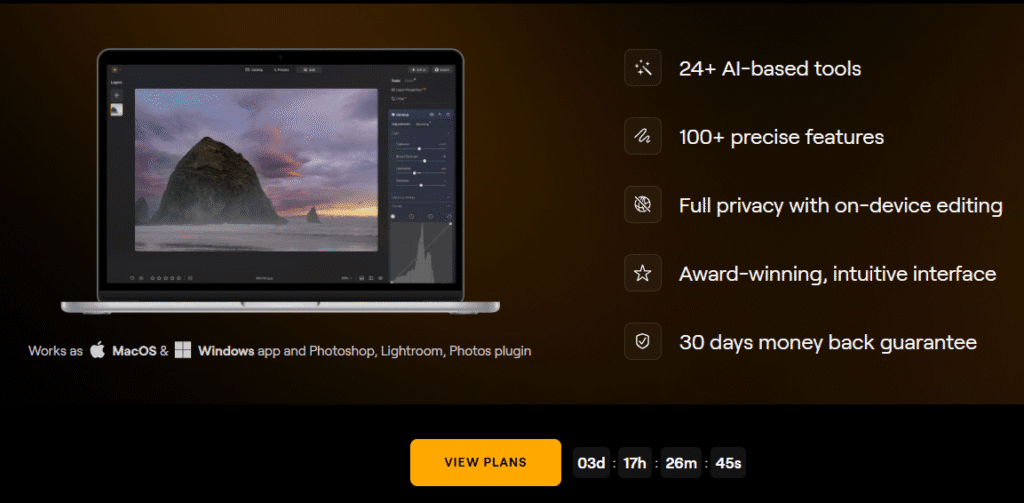
Pros and Cons of Luminar Neo: Luminar Neo review
Every Luminar Neo review should weigh both strengths and weaknesses so readers can make an informed decision. While Luminar Neo is packed with AI-driven features and creative tools, there are still areas where it may not be the perfect fit for everyone.
✅ Pros of Luminar Neo
- AI-Powered Editing – Tools like Enhance AI, Sky AI, Relight AI, and GenErase simplify complex edits in seconds.
- User-Friendly Interface – Clean layout designed for photographers of all skill levels.
- Cross-Platform Support – Available on Windows, macOS, and mobile with a cross-device license.
- Advanced Extensions – Options like Supersharp AI, Panorama Stitching, and Focus Stacking provide professional-grade editing capabilities.
- Non-Destructive Workflow – Edits don’t overwrite original files, giving flexibility and safety.
- Plugin Compatibility – Works seamlessly with Adobe Lightroom and Photoshop for hybrid workflows.
- Affordable Options – Flexible plans including one-time purchases and subscriptions.
❌ Cons of Luminar Neo
- Performance Variability – Speed can drop when handling very large RAW files or heavy AI edits.
- Learning Curve for Pro Features – While beginner-friendly, mastering advanced extensions takes time.
- Limited Asset Library – Compared to Photoshop, fewer built-in brushes, overlays, and creative assets.
- No Built-In DAM (Digital Asset Management) – Lacks full-fledged organizational features like Adobe Lightroom.
- Extra Cost for Extensions – Some of the most powerful tools require additional purchase.

👉 Try Luminar Neo today and see how it fits your workflow.
Luminar Neo review: Is Luminar Neo Safe and Reliable?
When reading any Luminar Neo review, one of the key questions users often ask is whether the software is safe, trustworthy, and reliable. Based on my own testing and research, Luminar Neo is a legitimate and secure product developed by Skylum, a well-established company known for its reputable photo editing software.
Safety of Luminar Neo
- Official Source Downloads – Luminar Neo can be safely downloaded from Skylum’s official website or authorized distributors, reducing the risk of malware or tampered files.
- Secure Installation – The installation package is verified, digitally signed, and free of third-party software.
- Privacy Commitment – According to Skylum’s privacy policy, user data is not shared or sold to third parties, which is important for photographers handling sensitive content.
Reliability in Daily Use
- Consistent Updates – Skylum regularly provides software updates, bug fixes, and improvements, ensuring Luminar Neo runs smoothly across supported devices.
- Cross-Platform Stability – Compatible with both macOS and Windows, Luminar Neo is optimized for professional workflows.
- Cloud Integration – With the Luminar Neo cross-device license and mobile access, users can securely edit across different devices without file corruption risks.
- Proven Track Record – Skylum, the company behind Luminar Neo, has been in the photo editing software market for years, with products trusted by millions of users worldwide.
FAQs About Luminar Neo
In this Luminar Neo review, let’s answer some of the most common questions potential users ask before deciding to buy or download the software.
What is Luminar Neo used for?
Luminar Neo is an AI-powered photo editing software developed by Skylum. It’s designed for quick yet professional-quality edits like sky replacement, portrait retouching, background removal, and creative enhancements.
Is Luminar Neo free?
No, Luminar Neo is not free. However, Skylum offers a free trial so users can test its features before purchasing. The full version requires either a perpetual license (one-time payment) or a subscription plan.
Can Luminar Neo replace Lightroom or Photoshop?
- Lightroom – Luminar Neo does not fully replace Lightroom’s cataloging and organizational tools but offers comparable editing capabilities.
- Photoshop – Luminar Neo lacks Photoshop’s advanced graphic design and compositing tools but is much simpler for photography-focused edits.
👉 Many photographers use Luminar Neo alongside Adobe products as a plugin.
Does Luminar Neo support RAW files?
Yes. Luminar Neo supports RAW files from most modern cameras, ensuring high-quality photo editing without losing detail.
Is Luminar Neo safe to download?
Yes. As covered earlier in this Luminar Neo review, the software is safe when downloaded directly from Skylum’s official website. It is malware-free and digitally signed for security.
What devices can I use Luminar Neo on?
- Desktop: Windows 10/11 and macOS 11.0 Big Sur or later.
- Mobile: Available for iOS, Android, and ChromeOS with the cross-device plan.
Does Luminar Neo get updates?
Yes. Skylum frequently releases updates, bug fixes, and feature enhancements to keep the software reliable and up to date.
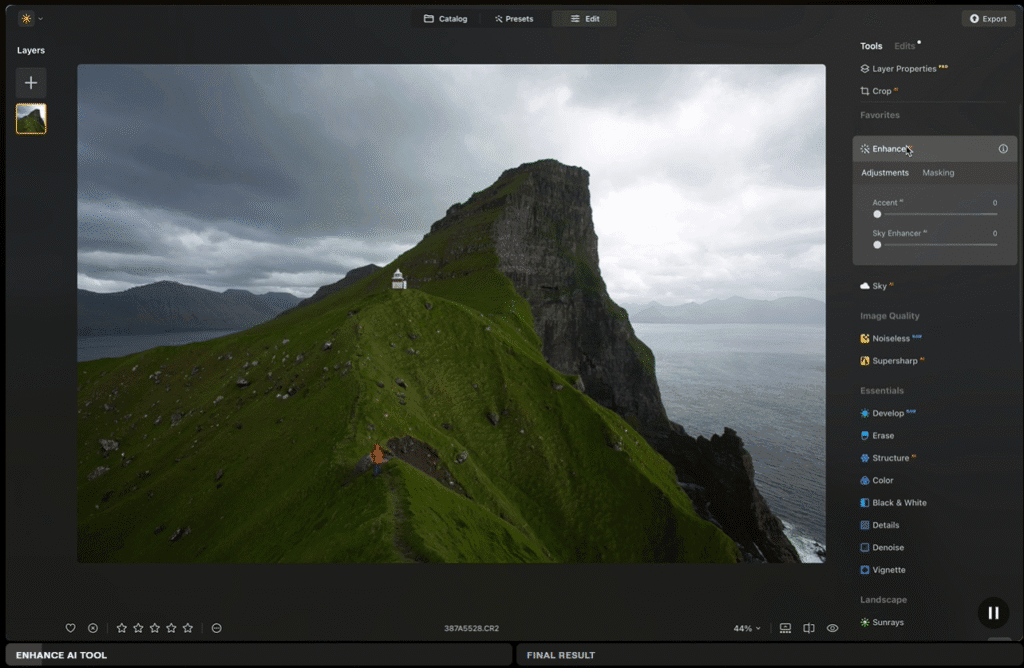
Conclusion: Is Luminar Neo Worth It?
After exploring this Luminar Neo review, it’s evident that Skylum has created a powerful photo editing solution that successfully merges professional-grade tools with AI-driven simplicity. In my experience, Luminar Neo strikes an impressive balance — it’s intuitive enough for beginners to start editing quickly, yet robust enough to satisfy advanced photographers who need fine control. Whether you’re enhancing casual portraits or crafting complex composites, Luminar Neo delivers both flexibility and creativity in one streamlined package.
Why Choose Luminar Neo?
- AI Efficiency – Tools like Enhance AI, Relight AI, and GenErase make complex edits simple and fast.
- Creative Freedom – Extensions such as Panorama Stitching, Focus Stacking, and Supersharp AI expand editing possibilities.
- Cross-Device Flexibility – With desktop and mobile support, it fits into different workflows.
- Affordable Options – Multiple pricing plans ensure flexibility whether you prefer a subscription or a one-time license.
- Plugin Compatibility – Works alongside Adobe Lightroom and Photoshop for hybrid users.
Who Will Benefit the Most?
- Beginners who want an easy-to-learn, AI-powered editor.
- Content creators looking for fast edits for social media and online branding.
- Professional photographers needing RAW support, batch processing, and advanced tools.
The Final Verdict
If you’re searching for an editing software that saves time, enhances creativity, and doesn’t require a steep learning curve, Luminar Neo is definitely worth considering. While it may not fully replace Lightroom’s organizational tools or Photoshop’s advanced design capabilities, it shines as a creative AI photo editor that fits a wide range of users.
Ready to transform your photos with AI-powered editing? 👉 Get Luminar Neo today and experience the difference for yourself
Looking for an alternative to Luminar Neo? Check out our Filmora vs Premiere Pro review to see which one is the better video editing tool for creators.


